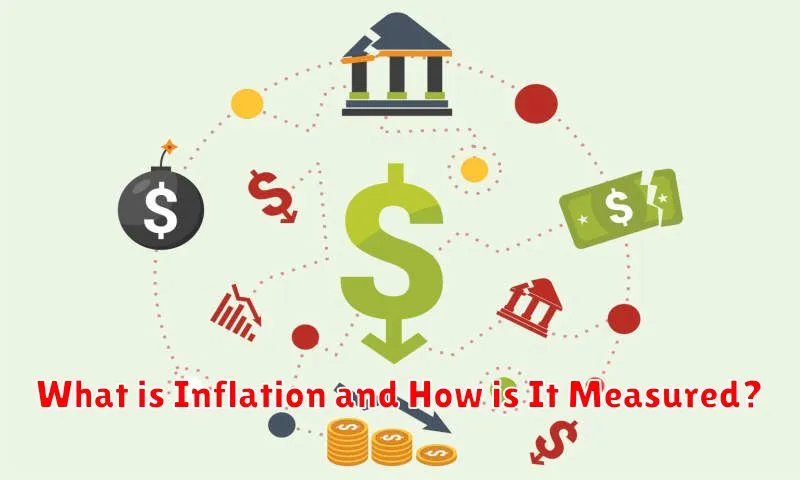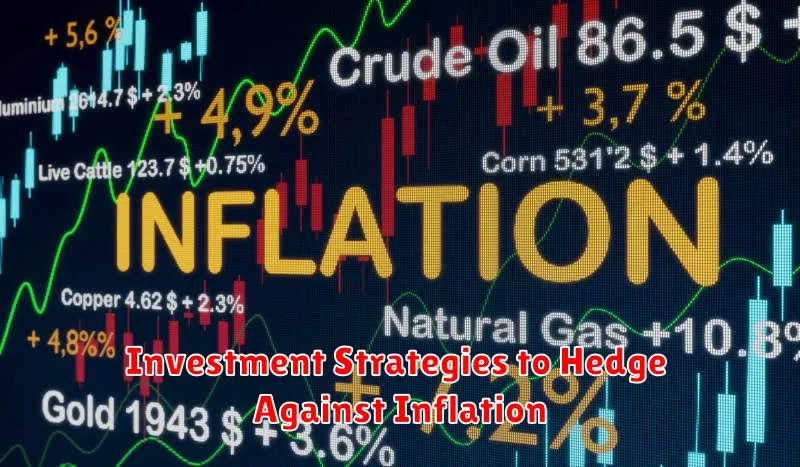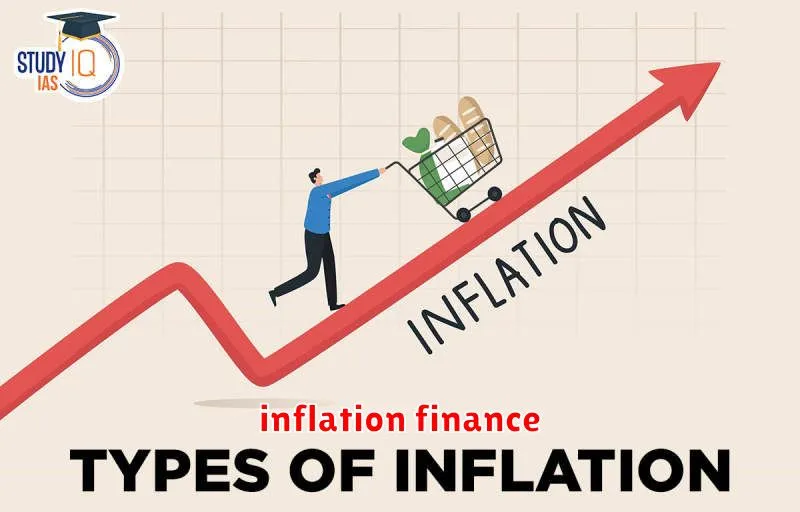Understanding inflation and its impact on your finances is crucial in today’s economic climate. This article will explore the complexities of inflation, explaining what it is, how it’s measured, and, most importantly, how it directly affects your purchasing power, savings, investments, and overall financial well-being. Learn how to navigate this economic force and protect your financial future.
What is Inflation and How is It Measured?

Inflation refers to a general increase in the prices of goods and services in an economy over a period of time. When the price level rises, each unit of currency buys fewer goods and services. Consequently, inflation reflects a reduction in the purchasing power per unit of money – a loss of real value in the medium of exchange and unit of account within the economy.
Measuring inflation typically involves tracking changes in a basket of goods and services that are representative of the consumption patterns of a typical household or economy. This basket includes items like food, housing, transportation, and healthcare. The most commonly used measure is the Consumer Price Index (CPI), which compares the price of this basket over time. Changes in the CPI are often expressed as a percentage, representing the rate of inflation.
Other measures, such as the Producer Price Index (PPI) which tracks prices at the producer level, and the GDP deflator, which measures the changes in prices of all goods and services produced within an economy, also provide insights into inflation.
It’s important to note that different measures may yield slightly different results due to variations in the basket of goods and services considered and the methodology employed.
Historical Trends and Economic Impact
Understanding inflation requires examining its historical trends. Throughout history, periods of high inflation have often been associated with significant economic disruptions. These periods frequently follow major events like wars or significant supply shocks, leading to dramatic increases in the price level.
Conversely, periods of low or stable inflation, sometimes referred to as price stability, are generally associated with stronger economic growth and stability. This stability allows businesses to make sound long-term investment decisions, and consumers to confidently plan for the future. Sustained periods of low inflation contribute to a more predictable and reliable economic environment.
The economic impact of inflation is multifaceted. High inflation erodes purchasing power, reducing the value of savings and wages. It can also lead to uncertainty in the market, hindering investment and economic growth. Conversely, moderate inflation can stimulate economic activity by encouraging spending before prices rise further. However, the optimal level of inflation remains a subject of ongoing debate among economists.
Analyzing historical inflation data provides valuable insights into the relationship between inflation rates and various economic indicators. This analysis helps policymakers develop effective strategies for managing inflation and mitigating its potential negative consequences. Careful consideration of historical trends informs economic policy and contributes to the overall stability of the financial system.
How Inflation Affects Purchasing Power
Inflation erodes purchasing power. As prices rise, each unit of currency buys fewer goods and services. This means that the same amount of money will buy less than it did before.
For example, if inflation is 2%, an item costing $100 today will cost $102 next year. Your $100 will buy less in the future. This reduction in purchasing power affects everyone, but disproportionately impacts those with fixed incomes or limited savings.
The impact is significant because it reduces the real value of your money. While your nominal income might increase, if inflation rises faster, your actual spending power diminishes. Effectively, you are poorer even if you earn more.
Understanding how inflation affects your purchasing power is crucial for effective financial planning. It necessitates adjusting savings and spending habits to maintain your desired standard of living amidst rising prices.
Impacts on Savings and Fixed Income
Inflation significantly erodes the purchasing power of savings and fixed-income investments. When prices rise, the real value of your money decreases. A dollar today buys less than a dollar did in the past, impacting the return on your savings accounts and certificates of deposit (CDs).
Fixed-income investments, such as bonds, are particularly vulnerable. The interest rate you receive might not keep pace with the inflation rate, resulting in a net loss in real terms. For example, if a bond pays 3% interest but inflation is 5%, your real return is actually -2%.
To mitigate the effects of inflation on savings and fixed income, consider diversifying your investments into assets that tend to perform well during inflationary periods. These could include real estate, commodities, or inflation-protected securities (TIPS).
Regularly reviewing your investment portfolio and adjusting your strategy based on inflation trends is crucial to safeguard your financial well-being.
Investment Strategies to Hedge Against Inflation

Inflation erodes the purchasing power of money, making it crucial to employ strategies that protect your investments. Real estate is often considered a good hedge, as property values tend to rise with inflation. Commodities, such as gold and oil, also historically perform well during inflationary periods, acting as a store of value.
Treasury Inflation-Protected Securities (TIPS) are government bonds that adjust their principal value based on inflation, offering a direct hedge against price increases. Investing in companies with strong pricing power, those able to pass increased costs onto consumers, can also help maintain profitability in an inflationary environment. This requires careful analysis of a company’s market position and competitive advantage.
Dividend-paying stocks can provide a consistent income stream that helps offset the effects of inflation. However, it’s essential to choose companies with a history of reliable dividend payments. Diversification across various asset classes is vital to mitigate risk and maximize returns in a dynamic inflationary environment. A well-diversified portfolio, tailored to your risk tolerance and financial goals, is key.
Remember that no investment strategy guarantees complete protection against inflation. Careful monitoring of your portfolio and adjustments based on market conditions are essential for long-term success. Consulting a financial advisor can provide personalized guidance tailored to your individual circumstances.
Adjusting Your Budget and Spending
Inflation’s impact on your finances necessitates a reassessment of your budget and spending habits. Rising prices mean your existing budget may no longer be sufficient to cover your needs and wants.
Prioritize essential expenses such as housing, food, and transportation. Carefully analyze your spending patterns to identify areas where you can cut back. Consider alternatives to expensive brands, explore cheaper transportation options, and look for ways to reduce your utility bills.
Track your spending meticulously. Utilize budgeting apps or spreadsheets to monitor your income and expenses. This provides clarity into your financial situation and helps you identify areas needing adjustment.
Explore potential income streams. Consider a part-time job, freelancing, or selling unused items to supplement your income and offset the impact of inflation. Increasing your income can alleviate financial stress caused by rising prices.
Adjust your savings goals. While saving remains crucial, it might be necessary to temporarily scale back your savings rate. Focus on maintaining a sufficient emergency fund to handle unexpected expenses.
Re-evaluate your debt management strategy. If possible, prioritize paying down high-interest debt to reduce the financial burden of interest payments during inflation.
Regularly reviewing and adjusting your budget based on inflation’s impact is vital for maintaining financial stability and ensuring your resources align with your financial goals. Flexibility and proactive adaptation are essential in navigating inflationary pressures.
Government Policies That Influence Inflation
Government policies significantly impact inflation. Fiscal policy, which involves government spending and taxation, can influence inflation. Increased government spending can boost demand, potentially leading to higher prices, while tax cuts can increase disposable income, similarly driving up demand. Conversely, reduced government spending or tax increases can curb inflation.
Monetary policy, controlled by central banks, plays a crucial role. The central bank manages the money supply and interest rates. Raising interest rates makes borrowing more expensive, reducing spending and investment, thus lowering inflation. Lowering interest rates has the opposite effect, potentially stimulating economic growth but also risking higher inflation. The central bank’s actions are key to managing the delicate balance between economic growth and price stability.
Regulatory policies also have an impact. Regulations affecting industries, such as price controls or subsidies, can directly influence prices. For example, price ceilings can lead to shortages and black markets, while subsidies can artificially lower prices in the short term, but potentially lead to long-term inflationary pressures.
Ultimately, the effectiveness of these policies depends on various economic factors and their interaction. Careful management of government policies is crucial for maintaining a stable and healthy economy, minimizing fluctuations in inflation.
How to Plan for Inflation in the Long Term
Long-term inflation planning requires a multifaceted approach. Diversification is key; don’t rely solely on cash savings. Consider investments that historically outperform inflation, such as stocks and real estate. Regularly rebalance your portfolio to maintain your desired asset allocation.
Increase your income streams to outpace inflation. This could involve seeking promotions, acquiring new skills, or exploring additional income opportunities. Regularly review and adjust your budget to account for rising prices. Consider prioritizing needs over wants and identify areas where expenses can be reduced.
Invest in yourself through education and skill development. This increases your earning potential and adaptability in a changing economic landscape. Also, plan for retirement by contributing regularly to retirement accounts that offer inflation-protected features, such as those adjusted for the Consumer Price Index (CPI).
Finally, stay informed about economic trends and inflation rates. Understanding these factors allows you to adapt your strategies proactively. Seek advice from a qualified financial advisor to personalize your long-term inflation plan based on your individual circumstances and risk tolerance.

